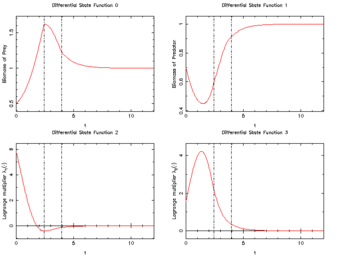Lotka Volterra fishing problem
| Lotka Volterra fishing problem | |
|---|---|
| State dimension: | 1 |
| Differential states: | 3 |
| Algebraic states: | 0 |
| Continuous control functions: | 0 |
| Discrete control functions: | 1 |
| Continuous control values: | 0 |
| Discrete control values: | 0 |
| Path constraints: | 0 |
| Interior point inequalities: | 0 |
| Interior point equalities: | 3 |
The Lotka Volterra fishing problem looks for an optimal fishing strategy to be performed on a fixed time horizon to bring the biomasses of both predator as prey fish to a prescribed steady state. The problem was set up as a small-scale benchmark problem. The well known Lotka Volterra equations for a predator-prey system have been augmented by an additional linear term, relating to fishing by man. The control can be regarded both in a relaxed, as in a discrete manner, corresponding to a part of the fleet, or the full fishing fleet.
It is thus an ODE model with a single integer control function. The interior point equality conditions fix the initial values of the differential states.
The optimal solution contains a singular arc, making the Lotka Volterra fishing problem an ideal candidate for benchmarking of algorithms.
Contents
[hide]Mathematical formulation
For ![t \in [t_0, t_f]](https://mintoc.de/images/math/5/5/8/55823791d9100bcb5461801aff4f6edd.png) almost everywhere the mixed-integer optimal control problem is given by
almost everywhere the mixed-integer optimal control problem is given by
![\begin{array}{llcl}
\displaystyle \min_{x, w} & x_2(t_f) \\[1.5ex]
\mbox{s.t.} & \dot{x}_0(t) & = & x_0(t) - x_0(t) x_1(t) - \; c_0 x_0(t) \; w(t), \\
& \dot{x}_1(t) & = & - x_1(t) + x_0(t) x_1(t) - \; c_1 x_1(t) \; w(t), \\
& \dot{x}_2(t) & = & (x_0(t) - 1)^2 + (x_1(t) - 1)^2, \\[1.5ex]
& x(0) &=& x_0, \\
& w(t) &\in& \{0, 1\}.
\end{array}](https://mintoc.de/images/math/e/9/3/e93178d5bd1af2eb33e434a69e6883c7.png)
Initial values and parameters
These fixed values are used within the model.
![\begin{array}{rcl}
[t_0, t_f] &=& [0, 12],\\
(c_0, c_1) &=& (0.4, 0.2),\\
x_0 &=& (0.5, 0.7, 0)^T.
\end{array}](https://mintoc.de/images/math/a/8/b/a8b6192b6bad3998ff2728a6397819b5.png)
Reference Solutions
Source Code
The differential equations in C code:
/* steady state with u == 0 */ double ref0 = 1, ref1 = 1; /* Biomass of prey */ rhs[0] = xd[0] - xd[0]*xd[1] - p[0]*u[0]*xd[0]; /* Biomass of predator */ rhs[1] = - xd[1] + xd[0]*xd[1] - p[1]*u[0]*xd[1]; /* Deviation from reference trajectory */ rhs[2] = (xd[0]-ref0)*(xd[0]-ref0) + (xd[1]-ref1)*(xd[1]-ref1);
The model in AMPL code with a collocation method. We need a model file lotka_ampl.mod,
# ---------------------------------------------------- # Solve Lotka Volterra fishing problem via collocation # ---------------------------------------------------- param T > 0; param nt > 0; param c1 > 0; param c2 > 0; param ref1 > 0; param ref2 > 0; param dt := T / nt; set I:= 0..nt-1; var x {I, 1..2} >= 0; var w {I} binary; minimize Deviation: dt * sum {i in I} ( (x[i,1] - ref1)*(x[i,1] - ref1) + (x[i,2] - ref2)*(x[i,2] - ref2) ) ; subj to ODE_DISC_1 {i in I diff {0}}: x[i,1] = x[i-1,1] + dt * ( x[i-1,1] - x[i-1,1]*x[i-1,2] - x[i-1,1]*c1*w[i-1] ); subj to ODE_DISC_2 {i in I diff {0}}: x[i,2] = x[i-1,2] + dt * ( - x[i-1,2] + x[i-1,1]*x[i-1,2] - x[i-1,2]*c2*w[i-1] );
a data file lotka_ampl.dat,
# ------------------------------------ # Data: Lotka Volterra fishing problem # ------------------------------------ # Problem parameters param T := 12.0; param nt := 101; param c1 := 0.4; param c2 := 0.2; param ref1 := 1.0; param ref2 := 1.0; # Initial values differential states let x[0,1] := 0.5; let x[0,2] := 0.7; fix x[0,1]; fix x[0,2]; # Initial values control let {i in I} w[i] := 0.0; param mysum;
and a running script lotka_ampl.run,
# ---------------------------------------------------- # Solve Lotka Volterra fishing problem via collocation # ---------------------------------------------------- model ampl_lotka.mod; data ampl_lotka.dat; option solver bonmin; solve;
Miscellaneous
The Lotka Volterra fishing problem was introduced by Sebastian Sager in a proceedings paper <bibref>Sager2006</bibref> and revisited in his PhD thesis <bibref>Sager2005</bibref>. These are also the references to look for more details.
References
<bibreferences/>
